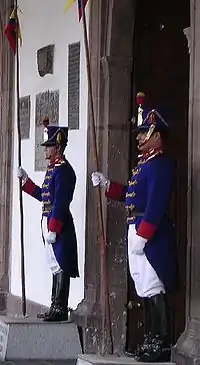Battle of Tarqui
| Battle of Tarqui | |||||||
|---|---|---|---|---|---|---|---|
| Part of the Gran Colombia–Peru War | |||||||
 Uniform of the Granaderos de Tarqui dating from the time of the Battle of Tarqui, today worn by the presidential guard of honor at the presidential palace of Quito. | |||||||
| |||||||
| Belligerents | |||||||
|
|
| ||||||
| Commanders and leaders | |||||||
|
|
| ||||||
| Strength | |||||||
| 5,000 men | 5,000 men | ||||||
| Casualties and losses | |||||||
|
360 killed & wounded 600 deserted |
400 killed 600 wounded 300 captured | ||||||

The Battle of Tarqui, also known as the Battle of Portete de Tarqui, took place on 27 February 1829 at Portete de Tarqui, near Cuenca, Ecuador. It was fought between troops from Gran Colombia, commanded by Antonio José de Sucre, and Peruvian troops under José de La Mar.
It was a victory for Gran Colombia in its first part, and a victory for Peru in its second part. After winning independence from Spain, the countries that are now Ecuador, Colombia, Panama and Venezuela formed a single nation known as Gran Colombia. Simón Bolívar, the liberator of most of the Andean countries in South America had hoped to join what is now Peru and Bolivia to Gran Colombia, but Peru (including what is now parts of Bolivia) chose to remain a separate nation. (Bolivia had earlier declared independence in 1826.)
The anniversary of the battle is marked as Army Day by the Ecuadorian Army.
Prelude
In 1828, José de Lamar the President of Peru, who had been born in Cuenca, was encouraged by influential citizens of Guayaquil to believe that the people of "el Austro" or the southern region of what is now Ecuador—including Cuenca, Guayaquil and Loja—would prefer to be part of Peru rather than Gran Colombia. José de Lamar, who also had the title of marshal or mariscal, occupied the city of Loja with Peruvian troops in November 1828. Guayaquil too was occupied by the Peruvian Army on the 20th of January the following year, angering the Gran Colombian government.
Battle
The President of Gran Colombia, Simón Bolívar appointed Mariscal Sucre, then President of Bolivia, to lead the Gran Colombian troops to defend the "Department of Ecuador." Helping Sucre was the Governor of the Department of Ecuador, Juan José Flores. Together Sucre and Flores recruited an estimated 5,000 troops by January 1829 and brought them into the area near Cuenca by the middle of February.
Lamar also had an estimated Peruvian 4,500 troops in the vicinity of Cuenca. The two armies were set to confront in Portete de Tarqui with the victory of the Grancolombian troops, in the first part of the battle, including an infantry brigade consisting of 3 battalions and a cavalry squadron under COL José María Camacaro, serving as part of the cavalry brigade under MGEN Daniel Florence O'Leary.
During the second part of the battle the Colonel's death in the battle by the 1st Squadron, Junin Hussars Regiment commanding officer, COL Luis Jose de Orbegoso y Moncada, who served with then LTCOL Domingo Nieto (later a Marshal) under the leadership of the Argentine general Mariano Necochea, shocked the Colombian forces so much that a cavalry charge was ordered, resulting in the Colombian forces (the Cedeño Squadron and two companies of riflemen) leading yet again into the offensive, but the Junin Hussars blocked them, forcing them to fall back to the line. By sunset the Peruvian forces pulled back, awaiting reinforcements.
In the aftermath, the Giron Agreement was signed by the general officers of both forces the day after, and as a result of the latter Piura Armistice of the 10 July 1829, all the Peruvian forces departed from southern Ecuador.
Shortly after the battle of Peruvians he returned to Peru, Lamar’s government was overthrown and he was forced to go into exile in Costa Rica where he died in November 1830. Sucre was killed in 1830 while riding on his way back to Quito. Juan José Flores became the first President of Ecuador.
In honor of the Ecuadorian fallen of the battle the Presidential Horse Guards Squadron of the Ecuadorian Army has the nickname "Tarqui Grenadiers" in honor of the battle, as a horse grenadier unit served with the Colombian army during the battle and was manned partly by Ecuadorian personnel. They wear a blue dress uniform and carry lances in memory of their fallen predecessors.
References
Bibliography
- Dupuy, R. E. and T. N. Dupuy. The Encyclopedia of Military History. (Philadelphia: Harper and Roe, 1986) p. 818
External links
- Compendio de Historia Militar del Perú Tomo I, Campañas bélicas, A la Gran Colombia: 1995, pp. 212-213.
- Carlos Dellepiane. Historia Militar del Perú. Tomo I, Capitulo III, La Guerra con la Gran Colomboa, pp. 279-303
- Jorge Basadre - Historia de la República del Perú 1822-1933, Tomo I, Capitulo 15, El Portete de Tarqui, pp. 289-293.
- Jorge Basadre - La iniciación de la República, Tomo Primero, La Mar y Gamarra en campaña, pagina 170.
- El Portete de Tarqui: victoria peruana. Nuestra lucha por la independencia, desde el asesinato de Atahualpa, hasta la guerra de 1828 por Miguel V. Merino Schröder, Imprenta Colegio Militar Leoncio Prado, 1950 - 343 páginas.
- Documentos de la guerra de 1828-1829, Antonio José de Sucre, Centro de Estudios Históricos del Ejército, 1992 - 82 páginas.
- Historia General del Ejército Ecuatoriano, El ejército en las guerras de la independencia, Tomo II, por el Teniente Coronel (sp) Dr. Edison Macías Núñez, Centro de Estudios Históricos del Ejército, páginas 108-121.
- Historia Militar del Ecuador, Parte I, Academia Nacional de Historia Militar, páginas 223-244.